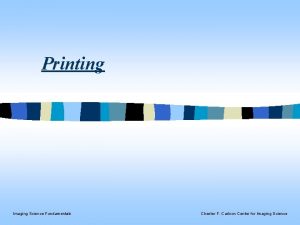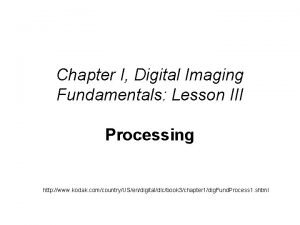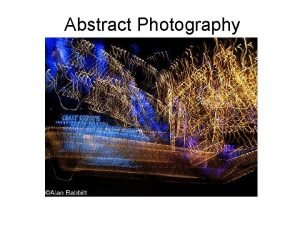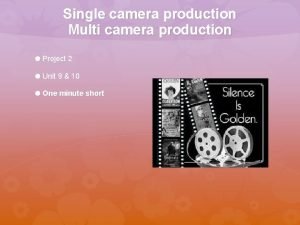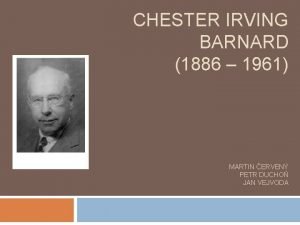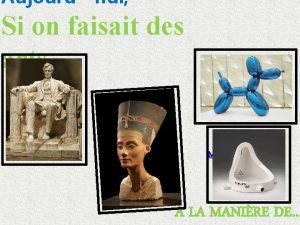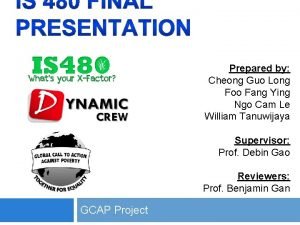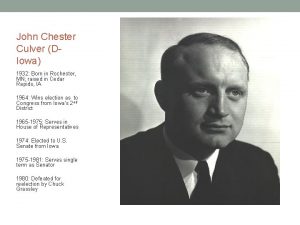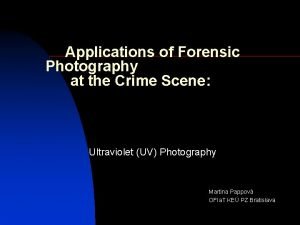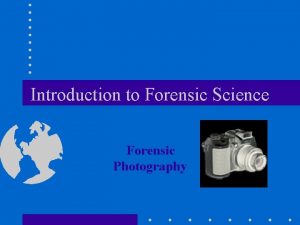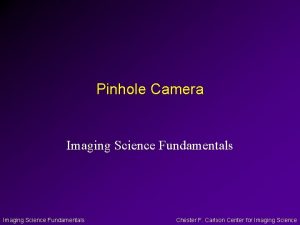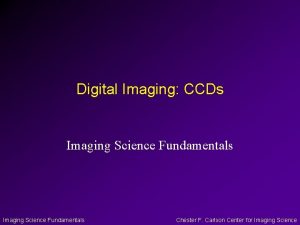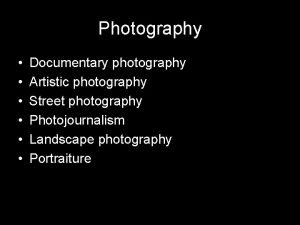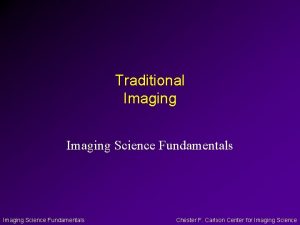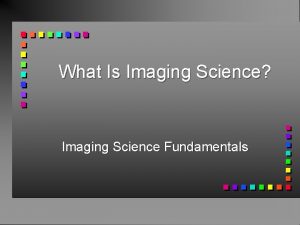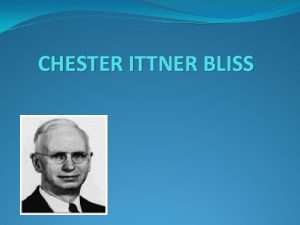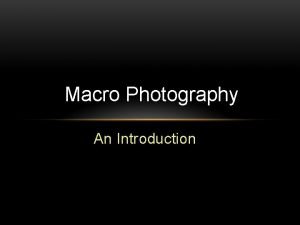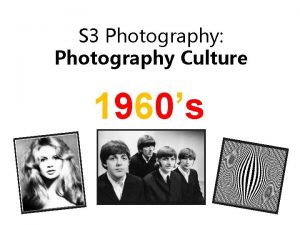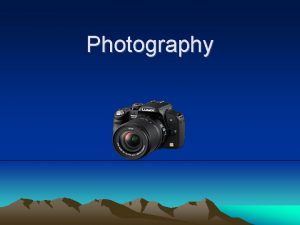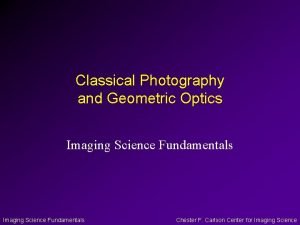The Camera and Photography Imaging Science Fundamentals Chester


































- Slides: 34

The Camera and Photography Imaging Science Fundamentals Chester F. Carlson Center for Imaging Science

Typical Imaging Chain for Photography source (sun) camera processing object Imaging Science Fundamentals collection (lens) exposure (aperture & shutter) detection (photographic film) image Chester F. Carlson Center for Imaging Science

Collection For a camera to be efficient, the pinhole is replaced by a lens. The lens redirects light rays emanating from the object. Imaging Science Fundamentals Chester F. Carlson Center for Imaging Science

Depth of Focus: The range of film locations for which the photo of an object at a given distance comes out acceptably sharp. Depth of Field: The range of object distances that result in an acceptable photograph. Imaging Science Fundamentals Chester F. Carlson Center for Imaging Science

Exposure Lens Aperture camera Shutter u Exposure is defined as the total amount of light falling on the film. u Exposure = Illuminance * Time Imaging Science Fundamentals Chester F. Carlson Center for Imaging Science

Illuminance Small aperture Large aperture u Illuminance is the rate of light falling on a given area (i. e. energy per unit time). u Illuminance is controlled by aperture: a larger aperture brings more light to the focus. Imaging Science Fundamentals Chester F. Carlson Center for Imaging Science

Aperture and “F number” d u F# (F number) is often used in photography to describe the aperture. u F# = focal length of the system/diameter of aperture Imaging Science Fundamentals Chester F. Carlson Center for Imaging Science

Exposure Time Shutter Closed Shutter Open u Exposure time is controlled by the shutter: when closed, the film is not exposed to light. u Exposure time is simply the time interval between opening and closing the shutter. Imaging Science Fundamentals Chester F. Carlson Center for Imaging Science

Types of Shutters Simplified Camera Between the Lens (BTL) Or Leaf Shutter Imaging Science Fundamentals Focal Plane Shutter Chester F. Carlson Center for Imaging Science

BTL or Leaf Shutter u Made CLOSED of overlapping “leaves” that slide out of the way when shutter opens. u Located between the imaging lens elements. OPEN Imaging Science Fundamentals Chester F. Carlson Center for Imaging Science

BTL or Leaf Shutter u Advantages u Uniform illumination independent of film size. u Entire film frame illuminated at once. u Disadvantages u Illumination of frame not constant over time. u Limitations on shutter speed. Imaging Science Fundamentals Chester F. Carlson Center for Imaging Science

Focal Plane Shutter u Metal or fabric with a narrow slit opening which traverses the area to be exposed. u Located just before the detector (film) at the focal plane. Imaging Science Fundamentals Chester F. Carlson Center for Imaging Science

Focal Plane Shutter u Advantages u Cost effective (one shutter needed for all lenses - great for interchangeable lens systems) u Can achieve very fast shutter speeds (~1/10000 sec) u Disadvantages u May cause time distortion if the film size is large (since the shutter slit must traverse the film) Imaging Science Fundamentals Chester F. Carlson Center for Imaging Science

Why control exposure with aperture and shutter? u Flexibility! u Fast shutter speed for freezing action (e. g. sports photography). u Slow shutter speed for low light levels (e. g. sunsets). u Small aperture for bright scenes or to enable longer exposures. u Large aperture for low light conditions (taking candle lit or moon lit pictures). Imaging Science Fundamentals Chester F. Carlson Center for Imaging Science

Capture u The image can now be captured using a detection system, such as photographic film. u Film must be processed to yield a permanent, visible image. Imaging Science Fundamentals Chester F. Carlson Center for Imaging Science

Image Capture - Photographic Film u Film consists of a photosensitive compound known as Silver Halide (Ag. X), which reacts with light. u The area exposed to light turns dark after processing. u The total amount of light hitting a given area of film (known as exposure) determines how dark that area turns. Imaging Science Fundamentals Chester F. Carlson Center for Imaging Science

What is “Silver Halide”? u Silver Halide is a compound made of silver (Ag) atoms and atoms from the halide group (Cl, Br, I) of the periodic table. u The material property of a silver halide crystal changes after absorbing photons. Imaging Science Fundamentals Chester F. Carlson Center for Imaging Science

Silver and halide atoms within the periodic table of the elements Silver (Ag) Halide group Imaging Science Fundamentals Chester F. Carlson Center for Imaging Science

Structure of a Typical B&W Film u Film base u Plastic u Antihalation backing u Prevents light from reflecting back. u Emulsion Silver Halide Crystals Suspended in gelatin, like fruits in Jell-O™! Imaging Science Fundamentals Chester F. Carlson Center for Imaging Science

Exposed Ag. X Crystals u When hn Exposure a silver halide crystal is exposed to light, some of the Ag. X molecules break up into their constituents, one of which is metallic silver (“pure” Ag). After Exposure Imaging Science Fundamentals Chester F. Carlson Center for Imaging Science

Processing Photographic Film u Turns latent image into visible image. u Basic steps: u Developer u Stop bath u Fix bath u All chemicals used in the process are in liquid form. Imaging Science Fundamentals Chester F. Carlson Center for Imaging Science

Silver Halide Process Chain Exposure Latent Image Processing Develop Stop Fix Visible (Stable) Image u. A latent image is formed after exposure (invisible to human eye). u After processing, the latent image is turned into a visible, stable image. Imaging Science Fundamentals Chester F. Carlson Center for Imaging Science

Processing Photographic Film Imaging Science Fundamentals u Developer “amplifies” the atomic silver to visible silver strands. u Stop Bath stops the development process. u Fix dissolves the unexposed Ag. X crystals, making the film safe to expose to light. u Wash with water to rinse fix chemicals away. Chester F. Carlson Center for Imaging Science

“Grain” of Film and Paper u Electron Photomicrographs of Emulsion Grains u (n. b. Measurement Bars indicate scale) Imaging Science Fundamentals Chester F. Carlson Center for Imaging Science

Silver Halide Grains Imaging Science Fundamentals Chester F. Carlson Center for Imaging Science

Why does processed film look “negative”? u Silver strands formed by exposure of photographic film to light actually appear dark (they are NOT shiny). u So, where light hits the film during exposure, it turns darker. Imaging Science Fundamentals Chester F. Carlson Center for Imaging Science

What determines how dark film becomes? u THE GRAINS! u Size u Shape u Chemical composition u Distribution Imaging Science Fundamentals Chester F. Carlson Center for Imaging Science

D-Log H Curve and Contrast More contrast Less contrast Image D Film response D Log H Imaging Science Fundamentals Log H Chester F. Carlson Center for Imaging Science

Photographic Finishing u In order to get a “positive” final print, the negative must be projected onto photographic paper. u Negative * negative = positive! u 2 basic “finishing” methods: CONTACT and ENLARGEMENT/REDUCTION Imaging Science Fundamentals Chester F. Carlson Center for Imaging Science

Contact Printing Light Negative Photographic Paper A CONTACT print: The negative is in direct contact with the photographic paper --essentially creating a shadow-gram. Imaging Science Fundamentals Chester F. Carlson Center for Imaging Science

Enlarger / Reducer Light Negative Photographic Paper Optics are used to produce an image of the negative on photographic paper. Imaging Science Fundamentals Chester F. Carlson Center for Imaging Science

Contact Printing vs. Enlarger Contact Printing u No loss of signal by the optics. u No reduction in resolution. u Simpler system. u Fixed image size. Imaging Science Fundamentals Enlarger u Flexible image size. u Some loss in resolution due to enlargement. u Additional optics may degrade final image quality. u Again, flexibility! Chester F. Carlson Center for Imaging Science

Latent Image Formation (Ex. : shadowgram) • Group of Ag. X Crystals • Mask (object) prevents Ag. X crystals underneath to be exposed. • “Unmasked” Ag. X is exposed to photons. • Exposed crystals have different material property (I. e. some Ag. X bonds have been broken). Imaging Science Fundamentals Chester F. Carlson Center for Imaging Science

Latent Image Formation (with optics) • Group of Ag. X Crystals • Optics used to image object onto the film. • Illuminated Ag. X is exposed to photons; but not all Ag. X is illuminated. • Exposed crystals have a different material property. Imaging Science Fundamentals Chester F. Carlson Center for Imaging Science
 Chester f carlson center rit
Chester f carlson center rit Frc driver station mac
Frc driver station mac Fundamentals of digital imaging
Fundamentals of digital imaging Is abstract photography same as conceptual photography
Is abstract photography same as conceptual photography Fundamentals of fashion photography
Fundamentals of fashion photography Why use single camera production
Why use single camera production Single camera vs multi camera
Single camera vs multi camera What is your favorite subject answer
What is your favorite subject answer Forensic science fundamentals and investigations chapter 6
Forensic science fundamentals and investigations chapter 6 Abyasa chester
Abyasa chester Chester agricultural center
Chester agricultural center Modern approaches of management
Modern approaches of management Chester barnard
Chester barnard Daniel chester
Daniel chester Conlan school
Conlan school Abyasa chester
Abyasa chester Tongue twisters examples
Tongue twisters examples Chester barnard informal organizations
Chester barnard informal organizations Debin gao
Debin gao Chester children's chorus
Chester children's chorus Chester john culver
Chester john culver Chester diocese re planning
Chester diocese re planning Chester barnard teoria
Chester barnard teoria Chester white pig
Chester white pig Abyasa pro
Abyasa pro Chester white pig
Chester white pig Chester esp
Chester esp Chester barnard teoria
Chester barnard teoria Naughtia childs
Naughtia childs West chester borough parking permit
West chester borough parking permit Chester university midwifery
Chester university midwifery Sue bliss chester le street
Sue bliss chester le street Ahmed chester
Ahmed chester Forensic photography management
Forensic photography management Digital photography in forensic science
Digital photography in forensic science
